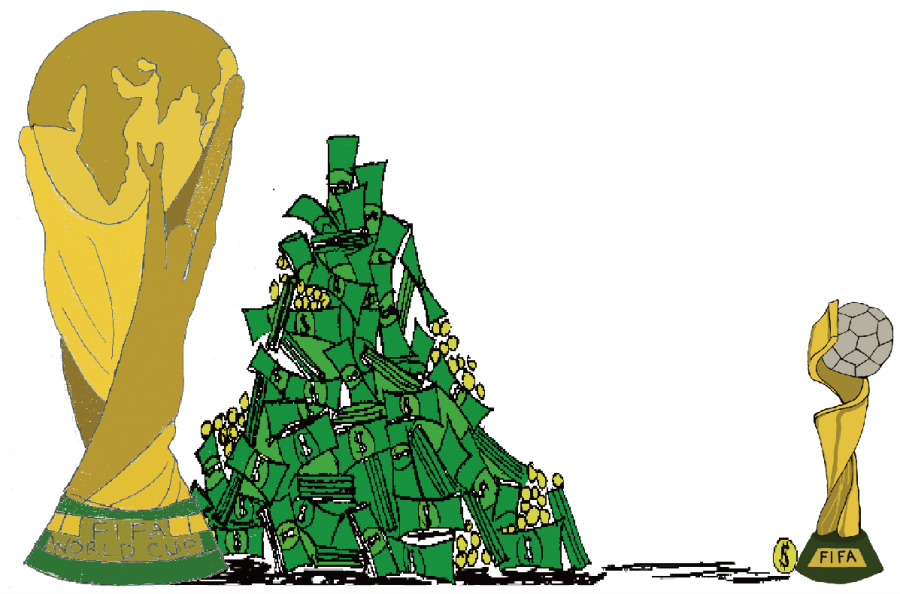Fans are at fault, not FIFA
Men’s earnings vs. Women’s earnings
The final whistle blew, and the U.S. Women’s National Soccer Team celebrated its first World Cup title in 16 years in Vancouver, Canada July 5. When the players arrived back in the states, the talk was not about the victory, but the relatively small amount of money the team won: $2 million. The $2 million figure is 17.5 times less than what the 2014 World Cup-winning German men’s national team took home: $35 million, according to FIFA.
The budget and winning team earnings ratio between the 2014 and 2015 World Cups is an important figure to suggest the reason for the low payout by FIFA to the U.S. women. The winning men receive 114 times less than their $4 billion budget, while the women take home only 45 times less than their $90 million budget. Though the majority of the men on the winning German national team make millions of dollars a year and members of the U.S. women’s team get by seemingly through endorsements, the money invested by the individual tournaments force the unequal payouts.
Immediate opinions target the pay inequities as an example of sexism, but those who endorse these feelings miss the big picture. FIFA’s ability to pay the participants is dependent upon the revenue brought in through each tournament. The men’s World Cup in 2014 brought in $1.4 billion, so giving each participant $1.5 million for just showing up doesn’t put a dent in FIFA’s budget. But the women’s World Cup in 2011 brought in $5.8 million, which doesn’t allow FIFA under any circumstance to make the two tournaments’ payouts equal.
Also, the excitement of men’s professional soccer is hard to see duplicated in the women’s game. From the production of talent from developmental academies and lucrative TV contracts, to the overall fan intrigue throughout the different leagues, the financial resources in the men’s game surpass those in the women’s game. Die-hard soccer fans seem more willing to pay to watch Lionel Messi play, who is worth $210 million, than Alex Morgan, who is worth $3 million.
Another part of the money side showing disparities in revenue from the men and women’s tournaments is through the broadcasting rights. ESPN paid $425 million for all FIFA tournaments between 2007 and 2014, while Fox paid $425 million between 2015 and 2022.The sponsorship deals in the previous Men’s World Cup surpass the total seen in this summer’s Women’s World Cup, for ESPN and Fox respectively. ESPN made $529 million, and Fox made an embarrassing $17 million, as the money disparities go beyond FIFA’s World Cup payouts, and into the advertising side of the game.
Though the women’s final game shattered TV ratings for a soccer game in the United States, women’s soccer is much smaller in terms of popularity elsewhere in the world. While 222 countries across the world have a men’s national team and pro league (13 countries not affiliated with FIFA), only 27 countries have a women’s national team and pro league (53 countries only have a national team). The men’s game is still most popular around the globe, keeping most of FIFA’s money within their game.
The World Cup winning team’s pay out is not an issue of sexism or gender equality; its basic economic practice of what generates higher profits has higher payouts.
Your donation will support the student journalists of Kirkwood High School. Your contribution will allow us to purchase equipment and cover our annual website hosting costs.

Grade: 12
Twitter handle: @dompal88
If you could be another Call staffer, who would you be?: Reese Anderson, he knows almost everything their is to...











Ellie Nash • Dec 14, 2015 at 10:02 am
In a very local sense, this is true. People are traditionally not as interested in female sports and they generally less capable of generating large revenue for sports companies. As such, Fifa is not anymore at fault of sexism than the rest of society is, but it points to much larger problems in our society’s treatment of girls. Our society discourages girls from being involved in sports, telling them that to be physically adept is a “masculine” trait. As such, fewer girls pursue any sports-related interests, as they feel pressured out of it, and girls sports continue to be under-appreciated by our society. So yes, Fifa is not doing anything different from the rest of society, but they are certainly doing nothing to stop sexism. They are engaging in the same practices as nearly everyone else and our society, and, if nothing else, are perpetuating sexism.